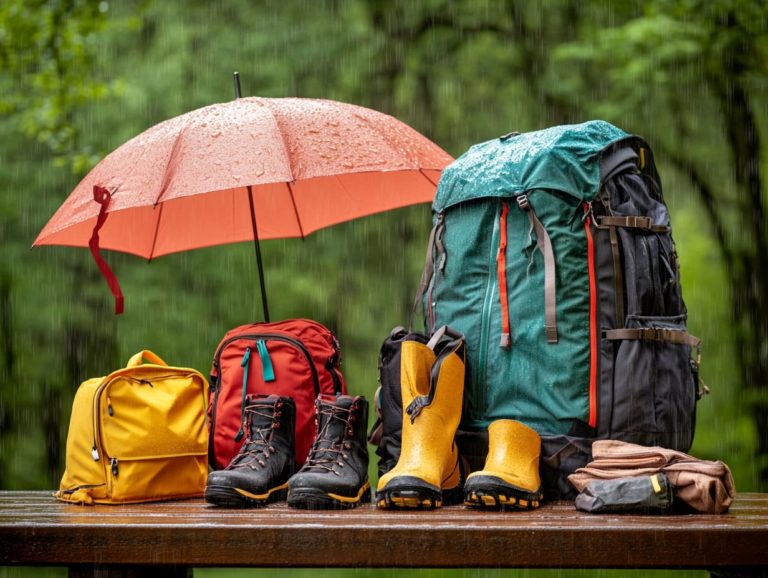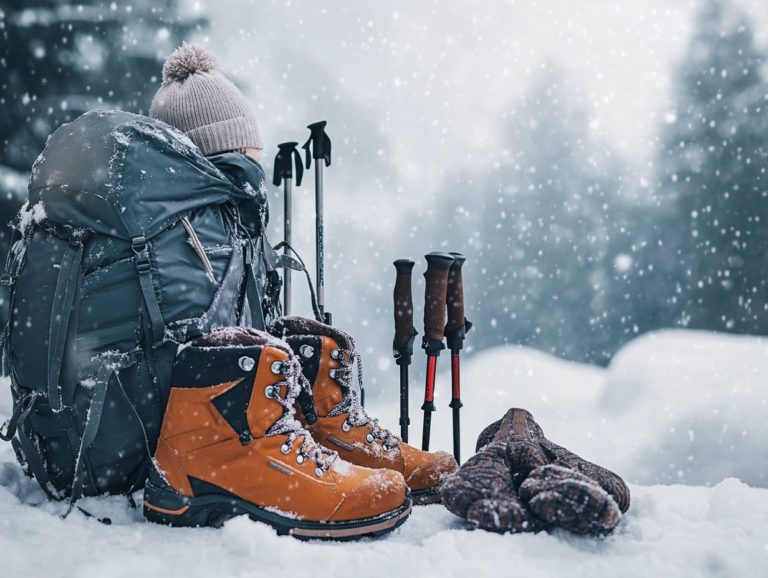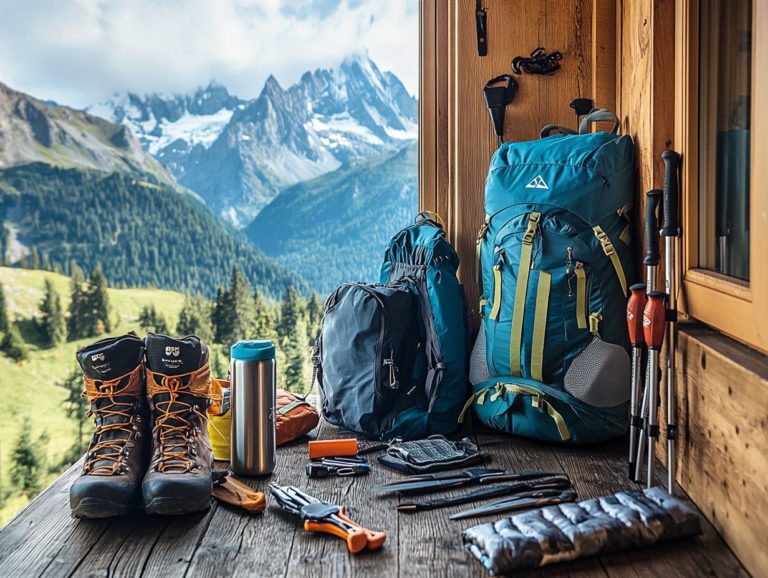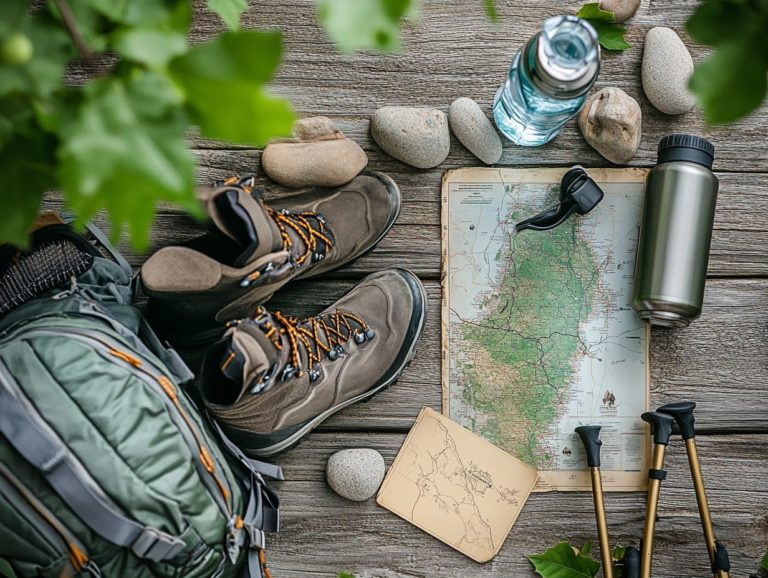How to Choose the Right Trail Map
Navigating the great outdoors can be an incredibly rewarding experience, but selecting the right trail map is crucial for ensuring a safe and enjoyable adventure.
With a variety of trail maps at your disposal, grasping their unique features can elevate your hiking experience. You’ll want to consider several factors when choosing a trail map, such as location, terrain, and level of detail.
This guide will delve into practical navigation techniques, expert recommendations, and the significance of keeping your trail map current. Get ready to explore!
Contents
- Key Takeaways:
- Understanding Trail Maps
- Factors to Consider when Choosing a Trail Map
- Using Trail Maps for Navigation
- Tips for Choosing the Right Trail Map
- Importance of Updating Trail Maps
- Frequently Asked Questions
- What factors should I consider when choosing a trail map?
- Should I choose a paper or digital trail map?
- Do I need a specialized trail map for certain activities?
- How important is accuracy in a trail map?
- Are there any online resources for choosing the right trail map?
- Should I always carry a trail map with me?
Key Takeaways:

- Choose a trail map that matches the location and terrain of your planned hike. Consider the level of detail and features provided to ensure an accurate and comprehensive guide for navigation.
- Use simple techniques like orienting the map and finding landmarks to navigate effectively. Seek expert recommendations and stay informed of changes to ensure a safe and successful hike.
- Regularly update your trail map to reflect any changes in the area. Stay informed through online resources or by contacting local authorities to ensure the most accurate and up-to-date information for your hike.
Understanding Trail Maps
Grasping the details of trail maps is essential for anyone setting off on a hiking adventure in Breckenridge. These maps offer invaluable insights into the hiking trails, showcasing their scenic vistas, levels of difficulty, elevation changes, and current trail conditions.
With a reliable hiking guide in hand, you can effortlessly navigate the diverse local trails, ensuring that your experience is both pleasurable and safe.
This understanding elevates your hiking journey, giving you the power to select paths that resonate with your group s dynamics and fit within your time constraints.
Types of Trail Maps
There are several types of trail maps available for you as a hiker, including topographic maps (maps that show elevation and terrain features), digital maps from apps like AllTrails, and printed maps that come with various features tailored to different hiking trails.
Each of these options caters to distinct needs, depending on the scenic qualities of your hike and your experience level. For instance, topographic maps offer detailed elevation profiles that help you identify challenging segments, highlighting both the aesthetic beauty and the difficulty of a particular route.
On the flip side, digital maps are often user-friendly and can be updated in real time, making them advantageous for navigating ever-changing landscapes. However, keep in mind that they can be battery-hungry, which may not be ideal for extended backcountry adventures.
Meanwhile, printed maps, despite lacking dynamic updates, can be invaluable for their reliability and clarity, providing you with a comprehensive view of the terrain.
Factors to Consider when Choosing a Trail Map
When selecting a trail map for your upcoming adventure in Breckenridge, several key factors should guide your decision. Consider the hiking experience you desire, the location and terrain of the trails, the level of detail the map offers, and the specific features and markings that will assist you in navigating effectively.
Each aspect plays a crucial role in ensuring that your journey is not only enjoyable but also safely guided by the right information.
Location and Terrain
The location and terrain of a hiking trail play a significant role in shaping your overall experience, and in Breckenridge, you ll find an impressive array of trails that vary in elevation and scenic beauty.
Take, for example, the steep inclines of the Quandary Peak Trail. It presents a formidable challenge that demands a solid level of physical fitness and careful navigation. In contrast, trails like Boreas Pass Road offer a more moderate experience, perfect for those seeking a leisurely hike amidst stunning views.
Stay alert! Trail conditions can change quickly with the seasons; snow-covered paths require the right gear and some extra hiking tips for safety. Fortunately, quick access to trailheads, especially those near the Breckenridge Ski Resort, means you can easily launch into your adventure. Just remember to check local maps and current conditions before you set off.
Level of Detail
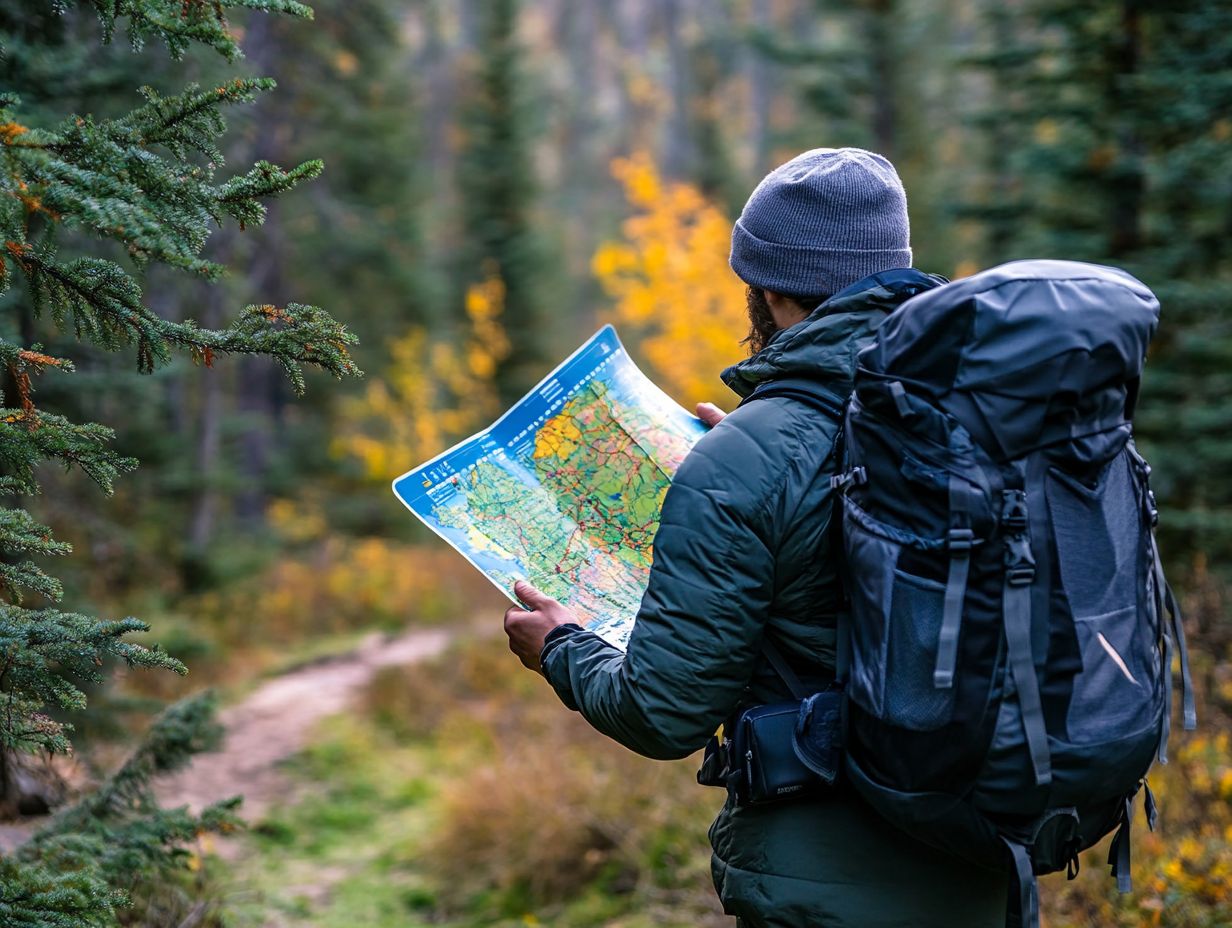
The level of detail in a trail map can significantly influence your navigation and planning. Detailed hiking guides provide essential information, such as trail profiles, elevation changes, and estimated hiking times.
As you immerse yourself in rich details, you gain insight into the physical demands of your journey. You also develop a clearer understanding of group dynamics that can affect overall enjoyment. Resources like AllTrails become invaluable tools; they equip you with insights into varying trail conditions, notable landmarks, and real-time updates from fellow adventurers.
By effectively utilizing such platforms, you can align your time budget with your group’s abilities. This ensures that every member is adequately prepared for the challenges ahead. A deeper understanding of trail dynamics can greatly enhance your hiking experience, leading to more informed decisions and safer adventures.
Features and Markings
Features and markings on a trail map offer invaluable insights into hiking trails. They help you identify key landmarks, points of interest, and important trail conditions that could affect your hiking experience.
These details are especially significant when you’re navigating unfamiliar terrain with confidence. For example, clear indications of trailhead access can direct you to the optimal starting point. Symbols that denote elevation changes and terrain types ensure you re well-prepared for the physical challenges ahead.
The addition of information like the ‘Muddy Meter’, a tool that helps gauge trail conditions, gives you the power to plan strategically and avoid muddy obstacles while assessing safety. By understanding these features, you elevate your decision-making process, ensuring a safer and more enjoyable outdoor adventure.
Utilizing trail maps for navigation is an essential and thrilling skill for every hiker, particularly in the varied terrain of Breckenridge. A solid grasp of fundamental navigation techniques can profoundly elevate your hiking experience while ensuring your safety on the trails.
Basic navigation techniques for hikers encompass understanding how to read trail maps, utilizing a compass effectively, and familiarizing yourself with trailhead access points. This ensures a seamless trekking experience.
These skills are essential for preventing you from becoming disoriented in unfamiliar terrain. Interpreting trail profiles can offer crucial insights into elevation changes and potential hazards, allowing for more informed route planning.
When setting out on a hike, always carry a physical map alongside your GPS devices, as batteries can be unreliable. Always check your surroundings to stay one step ahead of surprises! Stay vigilant for trail markers.
Regularly reviewing your direction with compass readings can significantly enhance your confidence. This ultimately makes each hiking adventure not only safer but also more enjoyable.
Tips for Choosing the Right Trail Map
Selecting the right trail map is crucial to the success of your hiking adventure in Breckenridge. By considering a few expert recommendations, you can elevate your overall experience and ensure you choose trails that align perfectly with your skill level and the dynamics of your group.
Expert Recommendations

Experts suggest that you utilize detailed hiking guides and platforms like AllTrails to discover reliable trail maps tailored to various skill levels, showcasing the finest hiking experiences in Breckenridge.
These resources not only present detailed topographical information but also feature user-generated reviews that illuminate recent trail conditions and potential hazards. As hiking expert John Muir wisely noted, grasping the nuances of local terrain can significantly enhance both safety and enjoyment on any adventure.
To elevate your outings, consider integrating hiking tips such as checking recent updates or weather forecasts; these can prove to be invaluable. Selecting the right mountain outfits that adapt to seasonal changes is also critical, as emphasized by outdoor gear specialist Sarah Thompson.
By embracing these insights, you set the stage for a truly enriching hiking experience.
Importance of Updating Trail Maps
Keeping your trail maps updated is vital for an incredible hiking adventure in Breckenridge! The importance of keeping trail maps updated cannot be emphasized enough, particularly for hikers in Breckenridge. With ever-changing trail conditions, new developments, and seasonal variations, your hiking experience and safety can be profoundly affected.
Staying informed ensures you navigate the trails with confidence and enjoy every moment of your adventure.
How to Stay Informed of Changes
Staying informed about changes to hiking trails is achievable through a variety of resources. You can utilize online platforms, follow social media updates, and consult reliable hiking guides or apps like AllTrails.
By leveraging these tools, you can ensure you have the latest information regarding how to get to the start of a trail and any environmental changes that might impact your hiking experience. Many local parks and recreation departments often maintain websites detailing trail conditions, closures, and maintenance alerts.
Engaging with local hiking clubs or community forums can provide valuable insights, as fellow hikers are often eager to share their firsthand experiences and advice about specific routes or recent trail modifications. This collaborative approach not only enhances your preparedness but also fosters a shared appreciation for the great outdoors.
Frequently Asked Questions
What factors should I consider when choosing a trail map?
When choosing a trail map, it is important to consider the scale, topography, and level of detail provided. You should also consider the type of trails you will be using and the level of experience of those using the map.
Should I choose a paper or digital trail map?
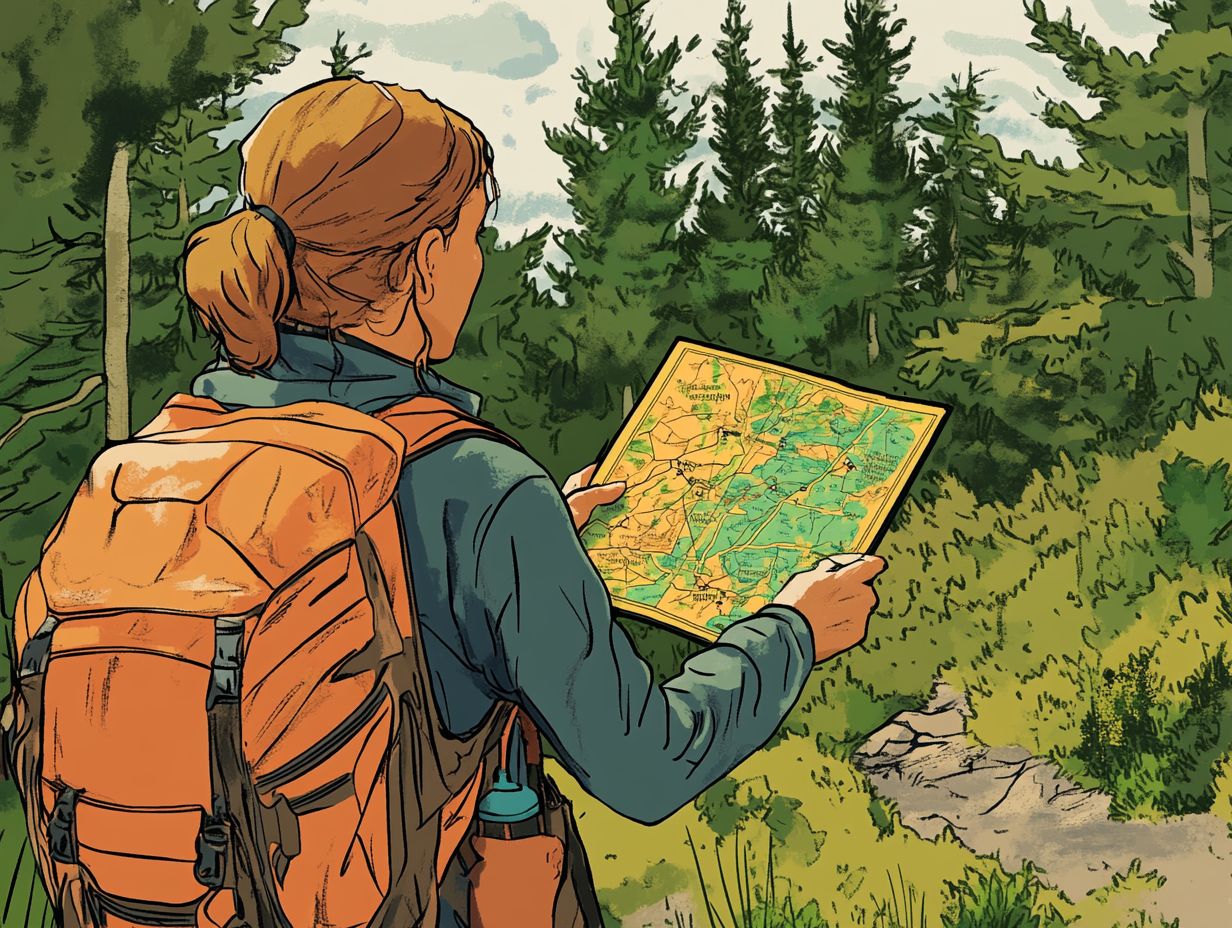
This depends on your personal preference and the type of trails you will be using. Paper maps are great for traditional navigation and have no risk of losing battery or signal. Digital maps can provide real-time updates and GPS tracking, but may not be as reliable in remote areas.
Do I need a specialized trail map for certain activities?
Yes, certain activities such as hiking, biking, or skiing may require more specific trail maps. These maps will often have additional information such as elevation, difficulty levels, and suggested routes for the specific activity.
How important is accuracy in a trail map?
Accuracy is crucial when choosing a trail map, as it can greatly impact your navigation and safety on the trails. Make sure to choose a map from a reputable source and double-check any information with other sources or fellow hikers.
Are there any online resources for choosing the right trail map?
Yes, there are many online resources and forums where hikers and outdoor enthusiasts share their experiences and recommendations for trail maps. It can be helpful to read reviews and compare different options before making a decision.
Should I always carry a trail map with me?
You should always carry a trail map when hiking. Unexpected changes can happen, and a map can help you navigate back to safety.

